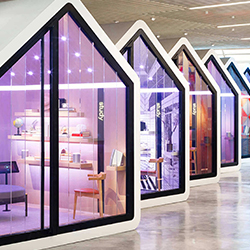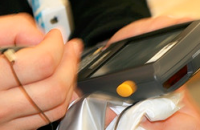How to Bring Experiential Retail to Your Retail Chain
 For years we’ve heard about the so-called retail apocalypse as stores close their doors. However, consumers still shop at brick-and-mortar locations, and their in-store shopping exceeds online purchases.
For years we’ve heard about the so-called retail apocalypse as stores close their doors. However, consumers still shop at brick-and-mortar locations, and their in-store shopping exceeds online purchases.
A survey by First Insight found that 71% of consumers spend more than $50 shopping in-store compared to 54% shopping online. The same survey found 34% spent more than $100 in the store, and only 21% spent the same online.
To win consumer attention and compete as retail evolves, retailers need to improve the customer experience. For many brands, enhancing the in-store experience means investing time and money in experiential retail stores.
What is Experiential Retail?
Experiential retail isn’t just an idea, it’s a revolution. As consumers continue to embrace online shopping, experiential retail lets brick-and-mortar stores stand apart from their online competitors in unique and new ways.
The definition of experiential retail isn’t defined by one certain type of store. Simply put, experiential retail is a store that offers an exclusive experience that engages the senses. The focus on building a connection between the brand and the consumer, not on sales.
Global retail research firm JLL identified six main touchpoints any experiential retail must include. Customer response to JLL’s Beyond Buying Consumer Study found that retail experiences must be the following:
- Intuitive
- Human
- Meaningful
- Immersive
- Personalized
- Accessible
The survey also found that there are five expectations consumers have for an “ideal” experience:
- A distinct interior
- Product that’s easy to find
- Knowledgeable associates
- Special rewards or promotions tied to consumer loyalty
- Something that creates a feeling of pride
The need for experiential retail has risen out of the growing influence of online shopping and the ability for consumers to research before stepping into a physical store. It’s one reason bed-in-a-box company Casper launched The Dreamery, a brick-and-mortar store in New York City.
Casper realized that the best way to let consumers test their beds was to let them sleep on the mattress in a comfortable environment. Visitors pay $25.00 to book a nap session at The Dreamery that comes complete with comfortable pajamas, snacks and refreshments, alongside books and skincare samples provided to truly recreate the feeling of going to bed at home. Naps take place in a Casper Nook, a pod outfitted with a Casper mattress and pillows.
Employees, deemed “Night Owls,” help explain the process to the customer and then leave them to drift off to dreamland. It was a smart choice on Casper’s part, especially since NRF has found that 80% of consumers are interested in attending a product demonstration.
Use Your Best Asset: Your Customers
Speaking of customers, they’re the best way to decide what to offer in your experiential store. Go straight to the source. Poll your customers to find out what they like about your store and what they consider it lacks. What pain points can you address?
You also have a world of shopper data at your fingerprints thanks to the Internet. You can look at common buying patterns, customer reviews, social media interactions and other forms of data. Your customers are telling you something about your brand, so it’s up to you to create an experiential retail experience that shows you hear them.
Nike did just that. It identified a common problem with shoe purchases and learned that half a million people complain about purchasing the wrong shoe size each year in North America alone.
As a result, the company decided to throw out the traditional foot ruler and the practice of using standard sizes for each pair of feet. Instead, it introduced Nike Fit, a program that uses machine-learning algorithms to analyze your foot.
Shoe shoppers can use Nike Fit via a smartphone app, but the in-store experience is more enhanced. Before choosing a pair of shoes, you stand on a special mat, and then an associate takes a photo of your feet. After that, Nike recommends the right shoe size based on your feet shape, length, type of shoe and other information.
Involve the Senses
One core focus of experiential stores must be an emphasis on a multi-sensory experience. Take, for example, Canada Goose. In April 2019, the brand announced plans to open six experiential stores.
Their most recent store opened in December 2019 in Toronto. However, unlike most stores, it lacks inventory. Instead, shoppers visit for a multi-sensory brand experience called “The Journey” to put the brand’s $1,000 parkas to the test.
First, shoppers make their way through the store entrance, or “The Crevasse,” an area with OLED floor panels made to simulate ice cracking. Next, shoppers are treated to 4K widescreen videos of British Columbia scenery and taken to a room to store their belongings. Once they’ve selected their parka, they can enter the Cold Room, which features daily snowfall and temperatures down to -12 degrees Celsius to test the parka’s warmth.
After getting a feel for what Canada Goose delivers, shoppers then make their way to a retail kiosk for assistance and to hopefully place an order.
Putting It All Together
Both the Canada Goose and the Casper experiences are exciting, so customers will likely be engaged to share their experiences on social media. They’re also custom-built environments for showcasing a brand’s products. And retailers of any size can follow the same model on a smaller scale.
For instance, if your store sells shoes, look for inspiration in how the customer wears the shoes in their daily life. If you want to show their stain resistance, create a “splatter” station where customers can try on a pair of shoes, then subject them to common spills, such as coffee, soda or wine. Sell backpacks? Invite your customers to toss a pile of books, a laptop and other heavy items to show the durability and comfort of your backpacks.
Even non-apparel items can be showcased with experiential stores. Across the pond in Bath, United Kingdom, is the charming bookshop Mr. B’s, which offers an exclusive “Reading Spa” experience. By incorporating the JLL touchpoints, the retailer is able to engage its customers in an intuitive and personalized way.
During the booking process, book lovers disclose their reading tastes, such as favorite authors and genres, so that Mr’s B’s can match them with the appropriately knowledgeable staff member or “bibliotherapist” and provide refreshments for an engaging book chat. The bibliotherapist then gathers a stack of books based on the conversation and leaves the reader to browse for their picks; the package also includes a voucher good for an CA$80 book purchase.
These reading spas are now so popular that they must be booked four to five months ahead.
Running a Seamless Retail Store
After you decide on the perfect retail experience, you need the right tools to pull it off without a hitch. Magstar offers a full line of retail management solutions to help you with every facet of the in-store experience, whether it’s customer relationship management or order fulfilment, to ensure your offerings match your customers’ needs.
Magstar is ready to help you take your retail store to the next level. If you want to see what we offer, Magstar President Steven Greenwood would love to give you a quick online demo at NRF 2020 (Jan. 12-14).
Book a Chat with Him Right Now!
RECENT POSTS
 Why POS Mobility is Becoming a Trend Among Top RetailersFor business owners in mid-sized retail, mobile POS is [...]
Why POS Mobility is Becoming a Trend Among Top RetailersFor business owners in mid-sized retail, mobile POS is [...] Magstar Ranked #1 in 5 Top-20 Software Vendor Categories by 2017 RIS News LeaderBoardMagstar Inc has been recognized as a top-20 software [...]
Magstar Ranked #1 in 5 Top-20 Software Vendor Categories by 2017 RIS News LeaderBoardMagstar Inc has been recognized as a top-20 software [...] Magstar Completes Major Upgrade At Vincor InternationalMagstar announces the completion of a major upgrade of [...]
Magstar Completes Major Upgrade At Vincor InternationalMagstar announces the completion of a major upgrade of [...]